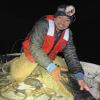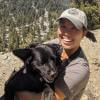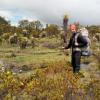With new technologies revolutionizing data collection, wildlife researchers are becoming increasingly able to collect data at much higher volumes than ever before. Now we are facing the challenges of putting this information to use, bringing the science of big data into the conservation arena. With the help of machine learning tools, this area holds immense potential for conservation practices. The applications range from online trafficking alerts to species-specific early warning systems to efficient movement and biodiversity monitoring and beyond.
However, the process of building effective machine learning tools depends upon large amounts of standardized training data, and conservationists currently lack an established system for standardization. How to best develop such a system and incentivize data sharing are questions at the forefront of this work. There are currently multiple AI-based conservation initiatives, including Wildlife Insights and WildBook, that are pioneering applications on this front.
This group is the perfect place to ask all your AI-related questions, no matter your skill level or previous familiarity! You'll find resources, meet other members with similar questions and experts who can answer them, and engage in exciting collaborative opportunities together.
Just getting started with AI in conservation? Check out our introduction tutorial, How Do I Train My First Machine Learning Model? with Daniel Situnayake, and our Virtual Meetup on Big Data. If you're coming from the more technical side of AI/ML, Sara Beery runs an AI for Conservation slack channel that might be of interest. Message her for an invite.
Header Image: Dr Claire Burke / @CBurkeSci

Explore the Basics: AI
Understanding the possibilities for incorporating new technology into your work can feel overwhelming. With so many tools available, so many resources to keep up with, and so many innovative projects happening around the world and in our community, it's easy to lose sight of how and why these new technologies matter, and how they can be practically applied to your projects.
Machine learning has huge potential in conservation tech, and its applications are growing every day! But the tradeoff of that potential is a big learning curve - or so it seems to those starting out with this powerful tool!
To help you explore the potential of AI (and prepare for some of our upcoming AI-themed events!), we've compiled simple, key resources, conversations, and videos to highlight the possibilities:
Three Resources for Beginners:
- Everything I know about Machine Learning and Camera Traps, Dan Morris | Resource library, camera traps, machine learning
- Using Computer Vision to Protect Endangered Species, Kasim Rafiq | Machine learning, data analysis, big cats
- Resource: WildID | WildID
Three Forum Threads for Beginners:
- I made an open-source tool to help you sort camera trap images | Petar Gyurov, Camera Traps
- Batch / Automated Cloud Processing | Chris Nicolas, Acoustic Monitoring
- Looking for help with camera trapping for Jaguars: Software for species ID and database building | Carmina Gutierrez, AI for Conservation
Three Tutorials for Beginners:
- How do I get started using machine learning for my camera traps? | Sara Beery, Tech Tutors
- How do I train my first machine learning model? | Daniel Situnayake, Tech Tutors
- Big Data in Conservation | Dave Thau, Dan Morris, Sarah Davidson, Virtual Meetups
Want to know more about AI, or have your specific machine learning questions answered by experts in the WILDLABS community? Make sure you join the conversation in our AI for Conservation group!
No showcases have been added to this group yet.
- @Bistra_Dilkina
- | she/her
Assoc. Prof. of Computer Science at USC and co-director of USC Center for AI in Society. Integration of machine learning and optimization, decision making, conservation planning, wildlife corridors, climate impacts, disaster resilience, wildlife trafficking.
- 0 Resources
- 0 Discussions
- 6 Groups
- @Amitkaushik
- | he/him/his
University of Georgia (UGA)
Environmental anthropologist; Ph.D. student in Integrative Conservation
- 0 Resources
- 1 Discussions
- 2 Groups
- @cbnatphoto
- | He / Him
Clay Bolt is the Manager of Pollinator Conservation for World Wildlife Fund-US and a conservation photographer focused on supporting policy that protects insects from pesticides and other threats. Clay’s words and images have appeared in publications such as National Geographic M
- 0 Resources
- 1 Discussions
- 3 Groups
Chartered Geographer and Fellow of the Royal Geographical Society. 35 years in GIS, currently Nature Products Lead at CreditNature. Main interests: biogeography, biodiversity, ecosystem integrity, ecosystem services, rewilding, nature tech, nature fintech.

- 0 Resources
- 1 Discussions
- 3 Groups
- @philipharman
- | He/him
I'm a data scientist living in Washington, DC.
- 0 Resources
- 0 Discussions
- 4 Groups
- @hjayanto
- | He/Him
KONKLUSI (Kolaborasi Inklusi Konservasi - Yayasan)
Your friendly Indo-Crocky-Croc



- 0 Resources
- 44 Discussions
- 17 Groups
- @nkarres
- | he/him
Senior Freshwater Scientist, The Nature Conservancy
- 0 Resources
- 1 Discussions
- 1 Groups
- @KeesteVelde
- | He/Him
Underwater Bioacoustician interested in developing PAM for freshwater systems

- 0 Resources
- 6 Discussions
- 7 Groups
- @MStarking
- | she/her/hers
Ecologist and conservation researcher, currently an Assistant Professor at University of Michigan-Flint, research areas include landscape ecology, forestry and wildlife interactions, wildlife habitat relationships, spatial ecology, GIS.

- 0 Resources
- 1 Discussions
- 15 Groups
- @linaquiceno
- | she/her

- 0 Resources
- 0 Discussions
- 2 Groups
- @taylorcasalena
- | she, her, hers
sustainability strategist, naturalist, consultant
- 1 Resources
- 1 Discussions
- 6 Groups
- 0 Resources
- 0 Discussions
- 7 Groups
Microchip has just announced the 1 GHz SAMA7G54 single-core Arm Cortex-A7 microprocessor (MPU) with MIPI CSI-2 and parallel camera interfaces, as well as up to four I2S, one SPDIF transmitter and receiver, and a 4-...
3 June 2022
Global Forest Watch's Small Grants Fund is now open for applications for the 2023 grant cycle. Deadline is August 1.
1 June 2022
The African Robotics Unit is looking for a Postdoctoral Research Associate to join A/Prof. Amir Patel’s lab at UCT. The Postdoc will investigate how sensor fusion can be leveraged to understand the locomotion of...
1 June 2022
Looking for biodiversity data? New review paper has an overview of biodiversity information portals, both global and country-specific
9 May 2022
Careers
The Department of Environmental Science, Policy & Management (ESPM) seeks applicants for the position of Executive Director for the Eric & Wendy Schmidt Center for Data Science & Environment (DS4E) at the...
9 May 2022
In Season Four of the Virtual Meetup Series, we’re bringing together leading engineers, conservationists, and academics to explore the future of technology in movement ecology and ask where exactly investment is needed...
29 April 2022
Check out this round-up of three of the latest conservation tech studies and news. See more conservation tech news by subscribing to our bi-monthly digest.
24 March 2022
Community Announcement
Are you an early career Kenyan conservationist looking to explore emerging conservation technologies while networking with a strong cohort of other female leaders? Apply now for our 6-month Women in Conservation Tech...
8 March 2022
We're proud to introduce the first WILDLABS On the Edge Fellows for 2022, Loretta Schindlerova and Meredith Palmer! Working alongside expert Edge Impulse mentors, these two fellows will use embedded machine learning to...
10 February 2022
We have a big vision for our Fellowships & Awards Programme: to create a better way for the tech industry to more meaningfully and impactfully engage with our conservation community. As we open our first fellowships...
28 January 2022
This article provides a review of deep learning (predominantly ML) used in marine ecology and considerations for its future directions in conservation. In plain language, the authors provide a methodology for training...
20 December 2021
Community Announcement
We've wrapped our first AI for Conservation Office Hours, a new programme where we set up 1:1 sessions with conservationists using or thinking about using AI so they could receive expert guidance from data scientists at...
14 December 2021
August 2025
event
September 2025
event
event
event
event
October 2025
event
event
event
December 2025
event
March 2026
August 2024
event
17 Products
Recently updated products
| Description | Activity | Replies | Groups | Updated |
|---|---|---|---|---|
| Hi everyone! My name is Leah Govia and I am a PhD candidate at the University of Guelph, Canada. My research explores what people... |
|
Ethics of Conservation Tech, Conservation Tech Training and Education, AI for Conservation | 1 year 6 months ago | |
| Hi Danilo. you seem very passionate about this initiative which is a good start.It is an interesting coincidence that I am starting another project for the coral reefs in the... |
|
Acoustics, AI for Conservation, Animal Movement, Camera Traps, Citizen Science, Climate Change, Community Base, Connectivity, Drones, Emerging Tech, Human-Wildlife Coexistence, Open Source Solutions, Sensors, Software Development, Wildlife Crime, Funding and Finance | 1 year 6 months ago | |
| I would recommend going with Ubiquity 2.4Ghz devices which have performed relatively well in dense foliage of the California Redwood forests. It took a lot of tweaking to... |
|
Acoustics, AI for Conservation, Connectivity, Open Source Solutions | 1 year 6 months ago | |
| Very nice video in the link you posted btw:Here is another less artistic one: |
|
Camera Traps, AI for Conservation | 1 year 7 months ago | |
| I'm also here for this. This is my first comment... I've been lurking for a while.I have 20 years of professional knowledge in design, with the bulk of that being software design... |
|
AI for Conservation, Camera Traps, Data management and processing tools, Software Development | 1 year 7 months ago | |
| Hi folks! Happy 2024 and thanks in advance for your patience in case I over-used tags. If you’re using any form of natural language... |
|
AI for Conservation, Citizen Science, Climate Change, Conservation Tech Training and Education, Data management and processing tools, Early Career, East Africa Community, Emerging Tech, Ending Wildlife Trafficking Online, Ethics of Conservation Tech, Human-Wildlife Coexistence, Open Source Solutions, Software Development, Wildlife Crime, Women in Conservation Tech Programme (WiCT) | 1 year 7 months ago | |
| BTW. I found out that the Jetson Orin NX 16GB module is drawing around 20W when running continuous inference, processing streams from 6x cameras at 6 fps.I'll try and find out... |
|
AI for Conservation | 1 year 7 months ago | |
| If you are considering an external microphone and a towed system, then you would also be in a position to consider a raspberry pi with an external microphone with sbts-aru.... |
|
Acoustics, AI for Conservation, Marine Conservation, Sustainable Fishing Challenges | 1 year 7 months ago | |
| @dmorris joined Variety Hour to give us 'a bunch of lightning talks inside a lightning talk'. Check out the recording to get a whirlwind... |
|
AI for Conservation, Drones, Geospatial | 1 year 8 months ago | |
| Also, take a look at TrapTagger. It has integration with WildMe. |
+4
|
AI for Conservation, Camera Traps | 1 year 8 months ago | |
| We are writing a methodology to measure Biodiversity density in habitats.Examining lots of different options but very keen to hear from... |
|
AI for Conservation | 1 year 9 months ago | |
| Hi @GermanFore ,I work with the BearID Project on individual identification of brown bears from faces. More recently we worked on face detection across all bear species and ran... |
|
AI for Conservation, Camera Traps, Data management and processing tools, Software Development | 1 year 9 months ago |
New: Satellites for Biodiversity Award
5 December 2022 2:08pm
Connection needed!
15 November 2022 4:23pm
24 November 2022 3:55pm
Thank you so much!
2 December 2022 3:14pm
Hahaha, now I see why you were asking ...
PhD Positions at University of Michigan CSE
23 November 2022 3:02pm
MozFest 2023 call for proposals on Tech & Biodiversity
22 November 2022 11:10am
Dear AI, We Have Trust Issues
14 November 2022 11:09pm
Hierarchical Deep Learning to Improve Automatic Classification of Pests and Biodiversity Monitoring in Agroecosystems
8 November 2022 3:46pm
Spatial Data Analysis, TNC
8 November 2022 11:34am
Senior AI Research Scientist, Earth Species Project
8 November 2022 11:27am
New paper: Integrating machine learning, remote sensing and citizen science to create an early warning system for biodiversity
7 November 2022 7:10pm
ConservationAI
20 October 2022 2:41pm
20 October 2022 7:32pm
Out of curiosity, what are the similarities/differences between your platform and other image classification ones such as Wildlife Insights, WildID, ZambaCloud? I don't mean that in like a "what's best" way, just would be great to better understand the the details so that people can assess what to try for their specific use cases & applications!
It would be great to have a comparative specs sheet of sorts! Peter Gyurov started something like that: https://www.notion.so/Camera-Trap-Pipeline-Solution-Comparison-2eac80825c4941b0b2b5fad3daea1cc3. Would be great to add ConservationAI to this list!
Conservation Technology Intern (Vietnam)
 Stephanie O'Donnell
and 1 more
Stephanie O'Donnell
and 1 more
19 October 2022 9:22am
Introducing G.AI.A: Artificial Intelligence and Planetary-Scale Environmental Management
13 October 2022 1:48am
Try AI Micro-Internship 2023
11 October 2022 5:42pm
Upcoming WWF Webinar Series: Artificial Intelligence and Conservation
11 October 2022 12:30pm
Artificial Intelligence and Conservation: Ethics
11 October 2022 12:28pm
Artificial Intelligence and Conservation: Prediction
11 October 2022 12:27pm
Artificial Intelligence and Conservation: Where We Are Now
11 October 2022 12:23pm
The Smart Biosphere: How Technology can provide regenerative resources at scale
10 October 2022 12:06pm
Frontiers Symposium: Digital tools for reversing environmental degradation
5 October 2022 10:23am
Multi-day workshop: Machine Learning Advances for Marine Acoustics & Imagery Data
4 October 2022 5:20pm
Audio Across Domains Workshop 2022
3 October 2022 7:54pm
3 October 2022 11:40pm
11 October 2022 2:05pm
18 Sustainability Job Opportunities at Google
3 October 2022 7:09pm
New paper - Rookognise: Acoustic detection & identification of individual rooks in field recordings using multi-task neural networks
3 October 2022 2:35pm
New paper - FathomNet: A global image database for enabling artificial intelligence in the ocean
27 September 2022 9:44pm
Conservation Tech Directory - new update!
29 August 2022 2:38pm
23 September 2022 5:26pm
Congrats on the milestone Carly and Gracie!
26 September 2022 10:07pm
Thanks so much!!
Mangrove soundscape
27 August 2022 4:57pm
29 August 2022 2:47pm
You might check out the devices listed in the Conservation Tech Directory - you can search for 'acoustic recorder' or 'ARU' or something like that.
The most common off-the-shelf models (other than Frontier Labs' BARLTs mentioned above😊) are Open Acoustic Devices Audiomoths & Hydromoths (which may be particularly useful for you since they come in completely watertight cases that can be stuck underwater for deployments), Wildlife Acoustics' SongMeter series, and Cornell Lab of Ornithology's Swift units.
30 August 2022 10:10pm
Camilo--
Are you interested only in airborne sounds or do you want to deploy hydrophones? That decision would inform a lot of other decisions about your purchase of equipment, as would having a clearer picture of your budget.
23 September 2022 5:39pm
Hi there Camilo,
What an interesting project! If you are looking for a lower cost, but effective tools for acoustic monitoring you might want to look into two options:
SoundTraps - are very commonly used and perform quite well:
SonarPoints - these are also a great instrument option:
page/sonarpoint | Desert Star Systems
The SonarPoint system is the third generation of Desert Stars passive underwater acoustics monitoring toolkits.
Senior Conservation Technology Expert Position (Consultancy) with the Global Wildlife Program
22 September 2022 5:35pm
Catch Up with the Variety Hour: October 2022
22 September 2022 1:59pm
WIA After Hours: Episode #5 - AI for Wildlife Conservation and Imageomics with Dr. Tanya Berger-Wolf
21 September 2022 6:53pm































































22 November 2022 2:46pm
Maybe she is not based in Asia, but you could check Lily Xu, who gave a presentation at the IUCN World Congress a year ago on using AI against poaching in Cambodia. The project is called Protection Assistant for Wildlife Security (PAWS).
For a summary of this project and another ( presented by a man ) see
Machine Learning against poaching and illegal logging – Rubber Boots Data
At the IUCN's World Conservation Congress I ran into two applications of machine learning (ML) to guard protected areas against direct detrimental human activity. Both stories are success stories but also both applications are in their early phases. In this post, I will compare the two and ask a couple of common sense questions that…